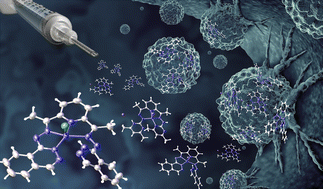Copper(ii) coordination compounds based on bis-hydrazones of 2,6-diacetylpyridine: synthesis, structure, and cytotoxic activity†
Abstract
By reacting a series of 2,6-diacetylpyridine bis-hydrazones containing pyrimidine (H2L1), benzimidazole (H2L2) and phthalazine (H2L3) heterocyclic fragments with copper(II) chloride and bromide, a variety of pentacoordinated complexes of the composition [Cu(H2L1)X]X, [Cu(HL2)X] and [Cu(HL3)X], where X = Cl−, Br−, are formed. The properties and structure of the compounds were studied by means of NMR, IR, UV-vis, ESR, and X-ray absorption spectroscopy, cyclic voltammetry and X-Ray single crystal diffraction methods. It was shown that complexes of the cationic type [Cu(H2L1)X]X have an asymmetric structure with a distorted square-pyramidal geometry of the coordination unit. The coordination polyhedron of metal chelates [Cu(HL2)X] and [Cu(HL3)X] is an almost ideal square pyramid. Investigations of the cytotoxic activity of the obtained compounds in vitro on human hepatocellular carcinoma (HepG2) and non-tumor human lung fibroblast (MRC-5) cell lines demonstrated that complexes show higher activity compared with the well-known anticancer agent cisplatin. In addition, metal chelates [Cu(H2L1)Cl]Cl, [Cu(HL2)Cl], [Cu(HL2)Br] and [Cu(HL3)Cl] were less toxic to non-tumor cells MRC-5. A study of the binding of complexes to bovine serum albumin (BSA) protein using fluorescence spectroscopy showed that copper complexes are strongly bound to BSA. To study the mechanism of interaction of the complexes with the DNA of cancer cells, molecular dynamics simulation of the compound [Cu(HL3)Cl] was carried out. It was shown that the complex enters into π-stacking interactions predominantly with adenine and thymine bases.



 Please wait while we load your content...
Please wait while we load your content...